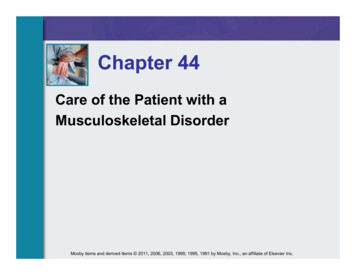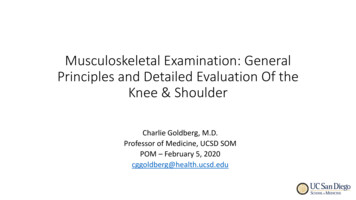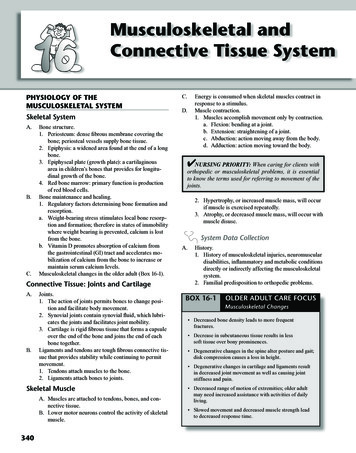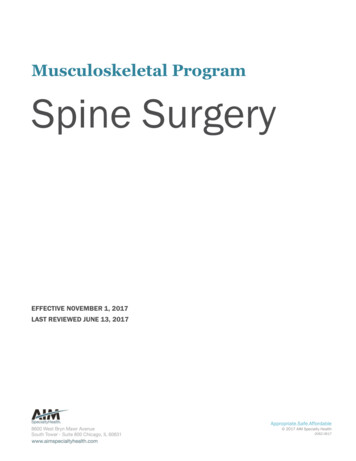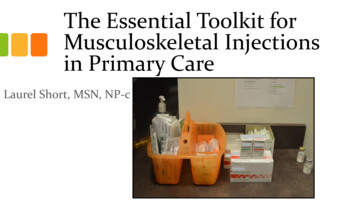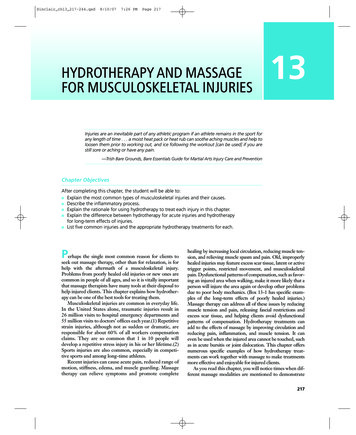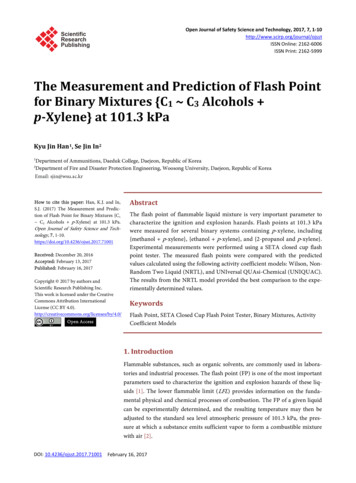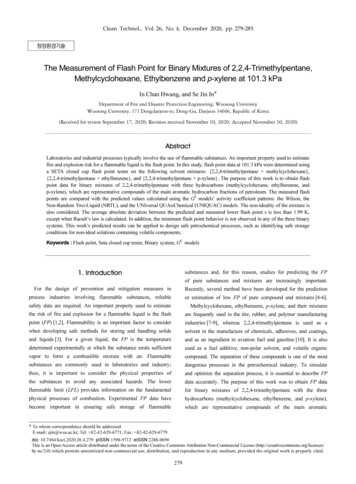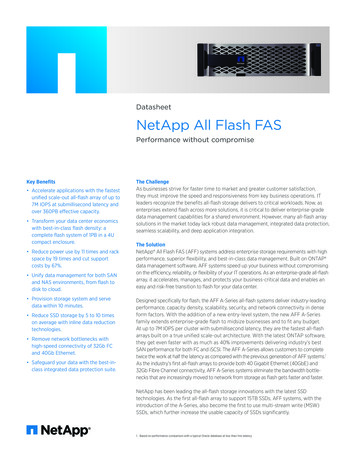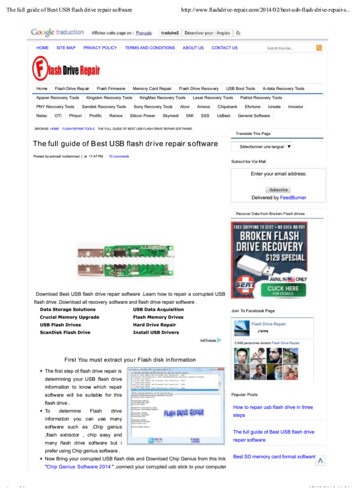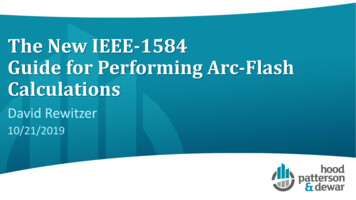
Transcription
Netter’sMusculoskeletal Flash CardsJennifer Hart, PA-C, ATCMark D. Miller, MDUniversity of Virginia
This page intentionally left blank
PrefaceIn a world dominated by electronics and gadgetry, learning from flash cardsremains a reassuringly “tried and true” method of building knowledge. Theytaught us subtraction and multiplication tables when we were young, and herewe use them to navigate the basics of musculoskeletal medicine. Netterillustrations are supplemented with clinical, radiographic, and arthroscopicimages to review the most common musculoskeletal diseases. These cardsprovide the user with a steadfast tool for the very best kind of learning—thatwhich is self directed.“Learning is not attained by chance, it must be soughtfor with ardor and attended to with diligence.”—Abigail Adams (1744–1818)“It’s that moment of dawning comprehension I live for!”—Calvin (Calvin and Hobbes)Jennifer Hart, PA-C, ATCMark D. Miller, MDNetter’s Musculoskeletal Flash Cards
1600 John F. Kennedy Blvd.Ste 1800Philadelphia, PA 19103-2899NETTER’S MUSCULOSKELETAL FLASH CARDS ISBN: 978-1-4160-4630-1Copyright 2008 by Saunders, an imprint of Elsevier Inc.All rights reserved. No part of this book may be produced or transmitted inany form or by any means, electronic or mechanical, including photocopying,recording or any information storage and retrieval system, without permissionin writing from the publishers. Permissions for Netter Art figures may be soughtdirectly from Elsevier’s Health Science Licensing Department in PhiladelphiaPA, USA: phone 1-800-523-1649, ext. 3276 or (215) 239-3276; or e-mailH.Licensing@elsevier.com.NoticeKnowledge and best practice in this field are constantly changing. As newresearch and experience broaden our knowledge, changes in practice,treatment, and drug therapy may become necessary or appropriate.Readers are advised to check the most current information provided (i) onprocedures featured or (ii) by the manufacturer of each product to beadministered, to verify the recommended dose or formula, the method andduration of administration, and contraindications. It is the responsibility ofthe practitioner, relying on his or her own experience and knowledge ofthe patient, to make diagnoses, to determine dosages and the besttreatment for each individual patient, and to take all appropriate safetyprecautions. To the fullest extent of the law, neither the Publisher nor theAuthors assume any liability for any injury and/or damage to persons orproperty arising out of or related to any use of the material contained inthis book. The PublisherISBN 978-1-4160-4630-1Acquisitions Editor: Elyse O’GradyDevelopmental Editor: Marybeth ThielPublishing Services Manager: Linda Van PeltDesign Direction: Steve StaveIllustrations Manager: Karen GiacomucciMarketing Manager: Jason OberackerPrinted in ChinaLast digit is the print number:98 76Working together to growlibraries in developing countrieswww.elsevier.com www.bookaid.org www.sabre.org54
Table of ContentsSection 1. The Shoulder and Upper ArmSection 2. Elbow, Wrist, and HandSection 3. The SpineSection 4. The Thorax and AbdomenSection 5. The Pelvis, Hip, and ThighSection 6. The Knee and Lower LegSection 7. The Ankle and FootNetter’s Musculoskeletal Flash Cards
Discover the art ofmedicine! 548 stunning, full page, handpainted illustrations bringanatomy to life. Painstaking revisions throughoutenhance the precision of every detail. More diagnostic imaging and clinical illustrationstranslate basic science into practice. www.netteranatomy.com gives you online access to aplethora of ancillary material, including 90 plates from thebook, human dissection videos, and much more.Atlas of Human Anatomy, 4th EditionBy Frank Netter, MD. 2006. 640 pp. 548 ills. Soft cover book pluswebsite access. ISBN: 978-1-4160-3385-1To order your copy,please visit www.elsevierhealth.comor your local medical bookstore.
Netter’s AnatomyFlash Cards, 3rd Edition(978-1-4377-1675-7)Netter’s Advanced Headand Neck Flash Cards –Updated Edition(978-1-4557-4523-4)Netter’s NeuroscienceFlash Cards, 2nd Edition(978-1-4377-0940-7)Netter’s MusculoskeletalFlash Cards(978-1-4160-4630-1)
This page intentionally left blank
1The Shoulder and Upper ArmPlates 1-1 to 1-22Bony Anatomy1-1Bony Anatomy: ShoulderRadiographic Anatomy1-2Radiographic Anatomy: ShoulderSoft Tissue Anatomy1-3Soft Tissue Anatomy: Shoulder JointMuscles1-4Muscles: Shoulder (Anterior View)1-5Muscles: Shoulder and Upper Arm (Posterior1-6Muscles: Rotator Cuff1-7Muscles: Upper ArmView)Arteries and Nerves1-8Arteries: Shoulder and Upper Arm1-9Brachial PlexusPhysical Examination1-10Physical Examination: Shoulder JointConditions1-11Conditions: Clavicle1-12Conditions: ScapulaNetter’s Musculoskeletal Flash Cards
1The Shoulder and Upper ArmPlates 1-1 to 1-221-13Conditions: Humerus1-14Conditions: Acromioclavicular Joint1-15Conditions: Subacromial Space1-16Conditions: Rotator Cuff1-17Conditions: Rotator Cuff1-18Conditions: Biceps Tendon1-19Conditions: Biceps Tendon1-20Conditions: Labrum and Shoulder1-21Conditions: Glenohumeral Joint Capsule1-22Conditions: Glenohumeral JointThe Shoulder and Upper ArmTable of Contents
Bony Anatomy: Shoulder342567191011812The Shoulder and Upper Arm1-1
Bony Anatomy: Shoulder1.2.3.4.5.6.7.8.9.10.11.12.Body of the scapulaGlenoidCoracoid processAnatomical neck of the humerusGreater tuberosity of the humerusLesser tuberosity of the humerusSurgical neck of the humerusSpine of the scapulaClavicleAcromioclavicular (AC) jointAcromionShaft of the humerusComment: The primary articulation of the shoulder joint is betweenthe glenoid of the scapula and the head of the humerus(glenohumeral joint). Other articulations here include theacromioclavicular and the sternoclavicular joints. The bony anatomydoes not provide much stability to the shoulder joint.The Shoulder and Upper Arm1-1
Radiographic Anatomy: Shoulder54637218AP view34268Lateral viewThe Shoulder and Upper Arm1-2
Radiographic Anatomy: Shoulder1.2.3.4.5.6.7.8.Body of the scapulaGlenoidCoracoid processClavicleAcromioclavicular (AC) jointAcromionGreater tuberosity of the humerusShaft of the humerusComment: Anteroposterior and axillary views are the most commonviews of the shoulder, and both should always be ordered in casesof suspected dislocation.The Shoulder and Upper Arm1-2
Soft Tissue Anatomy: Shoulder Joint21345867Shoulder joint, anterior view94101112Coronal section through jointThe Shoulder and Upper Arm1-3
Soft Tissue Anatomy: Shoulder Joint1.2.3.4.5.6.7.8.9.10.11.12.Coracoclavicular ligaments (conoid and trapezoid)Acromioclavicular ligamentCoracoacromial ligamentSupraspinatus tendonCoracohumeral ligamentSubscapularis tendonLong head of the biceps tendonJoint capsuleSubdeltoid bursaDeltoid muscleGlenoid labrumArticular cartilageComment: The secondary stabilizers (ligaments, muscles, and jointcapsule) provide most of the stability for the shoulder joint. Theglenohumeral ligaments are really just thickenings of theglenohumeral joint capsule.The Shoulder and Upper Arm1-3
Muscles: Shoulder (Anterior View)234516The Shoulder and Upper Arm1-4
Muscles: Shoulder (Anterior View)1.2.3.4.5.6.Pectoralis major muscleTrapezius muscleDeltoid muscleCephalic veinBiceps brachii muscleLatissimus dorsi muscleDeltoid MusclePectoralis MajorMuscleLatissimus DorsiMuscleOriginClavicle, acromion,scapular spineMedial clavicleand uppersternumT6-L5 spinousprocessesInsertionDeltoid tuberosity,humerusIntertuberculargroove ofhumerusIntertuberculargroove of humerusActionsPrimarily abduction,flexion, extensionArm adduction,assists rotationShoulderextension,adduction, andinternal rotationInnervationAxillary nerve(C5-6)Medial and lateralpectoral nerves(C5-T1)ThoracodorsalnerveThe Shoulder and Upper Arm1-4
Muscles: Shoulder and Upper Arm(Posterior View)32145The Shoulder and Upper Arm1-5
Muscles: Shoulder and Upper Arm(Posterior View)1.2.3.4.5.Deltoid muscleTrapezius muscleLevator scapulae muscleTeres major muscleTriceps brachii muscleTrapeziusMuscleTeres MajorMuscleLevator ScapulaeMuscleOriginOccipital bone,ligamentumnuchae, spinousprocessesC7-T12Inferior angle of thescapulaTransverseprocess of C1-4InsertionLateral clavicle,medial acromion,scapular spineMedialintertuberculargroove of humerusSuperior medialscapulaActionsPrimarilyscapular rotationHelps extend,adduct, and mediallyrotate the armScapular elevationand rotationInnervationSpinal accessorynerve (cranialnerve XI)Lower subscapularnerve (C5-C6,C6-C7)Third and fourthcervical nerves,dorsal scapularnerve (C5)The Shoulder and Upper Arm1-5
Muscles: Rotator Cuff1Anterior view234Posterior viewThe Shoulder and Upper Arm1-6
Subscapularis muscleSupraspinatus muscleInfraspinatus muscleTeres minor muscleSupraspinatusMuscleInfraspinatusMuscleTeres MinorMuscleSubscapularisMuscleOriginSupraspinous fossaof scapulaInfraspinous fossaof scapulaLateral border ofthe scapulaSubscapular fossaand lateral border ofscapulaInsertionGreater tuberosity ofhumerusGreater tuberosityof humerusGreater tuberosityof humerusLesser tuberosity ofhumerusActionsShoulder abduction,external rotationShoulder externalrotationShoulder externalrotation and assistswith adductionShoulder internalrotation andadductionInnervationSuprascapular nerve(C5-6)Suprascapularnerve (C5-6)Axillary nerve(C5-6)Subscapular nerves(C5-6)Muscles: Rotator CuffThe Shoulder and Upper Arm1.2.3.4.1-6
Muscles: Upper Arm124231Superficial layerSuperficial layer3Deep layerThe Shoulder and Upper Arm1-7
Coracobrachialis muscleBiceps brachii muscle (long and short heads)Brachialis muscleTriceps brachii muscle (long, lateral)Biceps BrachiiMuscle (Long andShort Heads)Triceps BrachiiMuscle (Long,Lateral, and MedialHeads)CoracobrachialisMuscleBrachialis Muscle1-7OriginCoracoid process(short head);supraglenoidtubercle of scapula(long head)Infraglenoid tubercleof scapula (longhead), posteriorhumerus (lateralhead), posteriorhumerus inferior toradial groove (medialhead)Coracoid processof scapulaDistal anteriorhumerusInsertionRadial tuberosityPosterior proximalolecranonMedial aspect ofmidshaft ofhumerusTuberosity andanterior coronoidprocess of ulnaActionsFlexion andsupination at elbowExtension at theelbowShoulder flexionand adductionElbow flexionInnervationMusculocutaneousnerve (C5-6)Radial nerve (C7-8)Musculocutaneousnerve (C6-7)Musculocutaneousnerve (C5-6),branch of radialnerve (C7)Muscles: Upper ArmThe Shoulder and Upper Arm1.2.3.4.
Arteries: Shoulder and Upper ArmAnterior view678543291011121The Shoulder and Upper Arm1-8
Arteries: Shoulder and Upper Arm1.2.3.4.5.6.7.8.9.10.11.12.Brachial arterySubscapular arteryPosterior and anterior humeral circumflex arteryAxillary arteryDorsal scapular arterySuprascapular arteryThyrocervical trunkSubclavian arteryThoracoacromial arteryAcromial branchDeltoid branchPectoral branchComment: The subclavian artery becomes the axillary artery as itpasses underneath the clavicle and later becomes the brachial arteryat the inferior border of the teres major muscle. The brachial arterydivides in the arm into the radial and ulnar arteries. The main bloodsupply to the humeral head is provided by the anterior humeralcircumflex artery.The Shoulder and Upper Arm1-8
Brachial he Shoulder and Upper Arm1-9
Brachial .19.20.21.RootsTrunksSuperior trunkMiddle trunkInferior trunkDivisions (posterior and anterior)CordsLateral cordLateral pectoral nervePosterior cordUpper, middle, and lower subscapular nervesMedial cordMedial pectoral nerveMedial brachial cutaneous nerveMedial antebrachial cutaneous nerveTerminal branchesMusculocutaneous nerveAxillary nerveRadial nerveMedian nerveUlnar nerveComment: The brachial plexus is formed by the nerve roots of C5,C6, C7, C8, and T1. Injuries typically occur when the plexus isstretched while the shoulder is depressed and the neck is laterallyflexed to the opposite side. A helpful mnemonic for the arrangementof the plexus (roots, trunks, divisions, cords, branches) is “RobTaylor drinks cold beer.”The Shoulder and Upper Arm1-9
Physical Examination: Shoulder JointSlight external rotationand abduction requiredto reach maximalelevation180 – 160 Flexion andextension180 Abduction90 60 Flexion(elevation)ExtensionAbduction60 0 0 Internal rotationMay be tested witharm held at side orabducted to 90 C790 Arm held at sideExternal rotationT70 Arm abducted 90 from sideMaximal internalrotation is highestmidline spinousprocess reached byextended thumb(T7 in young adults)The Shoulder and Upper ArmS11-10
Physical Examination: Shoulder JointType of MovementNormal Range of MotionFlexion160-180 degreesExtension45-60 degreesAbduction160-180 degreesExternal rotation40-60 degreesInternal rotationMidthoracic: 55 degreesTest/SignReason for EvaluationApprehension/relocationShoulder instabilitySulcus signInferior shoulder instabilityImpingement sign (Neer and Hawkins)Impingement/bursitisSupraspinatus stress testExternal rotation strengthRotator cuff tearDrop arm signMassive rotator cuff tearLift off testBelly press testSubscapularis tearSpeed testYergason testBicipital tendinitisO’Brien test (active compression)Superior labrum anterior to posterior(SLAP) tearJerk testPosterior labral tearWall push-upScapular wingingCross-body adduction testAcromioclavicular (AC) jointarthritis/osteolysisThe Shoulder and Upper Arm1-10
Conditions: ClavicleSuperior surface1Inferior surface243Identify each condition56The Shoulder and Upper Arm1-11
Conditions: Clavicle1.2.3.4.5.6.ShaftAcromial facetConoid tubercleSternal facetMidshaft clavicle fractureDistal clavicle fractureClavicle FracturesMechanismFall onto “point” of shoulderDiagnosisPain, tenderness, deformityImagingPlain radiographsComputed tomography to determine nonunion ifnecessaryTreatmentGenerally conservativeSurgical IndicationsExcessive shorteningSkin
Netter’s Anatomy Flash Cards, 3rd Edition (978-1-4377-1675-7) Netter’s Advanced Head and Neck Flash Cards – Updated Edition (978-1-4557-4523-4) Netter’s Musculoskeletal Flash Cards (978-1-4160-4630-1) Netter’s Neuroscience Flash Cards, 2nd Edition (978-1-4377-0940-7) This page intentionally left blank. Netter’s Musculoskeletal Flash Cards 1 The Shoulder and Upper Arm Plates 1-1 to .

